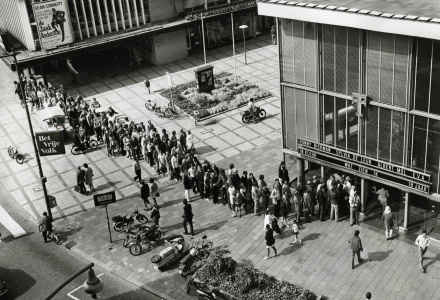Film’s Heyday – and Its Decline
Directly after WWII, cinema attendance reached an all-time high. In total, nearly 90 million tickets were sold in 1946 – a record that has never been (and never will be) broken. In the 1950s, attendance dropped to an average of about 65 million and then plummeted in the 1960s to circa 25 million, where it stabilised.
There are many reasons for this decline. In his dissertation titled In het wereldfilmstelsel, Bart Hofstede describes three things that contributed in different degrees to the drop in attendance. These are: the emergence of television, social changes in the 1960s (including suburbanisation, expanding mobility, and shifts in the way leisure time was spent) and the aging of cinemas themselves. The decline resulted in many cinemas closing their doors. Still others remodelled, converting their large theatres into several smaller ones to increase the number of films that could be shown. In doing so, cinema owners hoped to turn the decline around.
After things stabilised in the 1970s and 1980s, there was another dip in the early 1990s, with the absolute lowest attendance rate in 1992 at 14 million. After that, there was a gradual increase. This was explained in part by the rise of large mega-cinemas that were built in the mid-1990s. The popularity of Dutch children’s and young adult films played a role as well.
Everything Is Relative
If one considers the relative results instead of the absolute statistics, then there’s one change that’s particularly notable. Up until the early 1970s in the Netherlands, the number of people attending American films was more or less equal to those attending films from other countries (with the exception of the first decade after WWII, when American films accounted for 75% of all ticket sales). German films were very popular in the 1950s – with teen idols such as Conny Froboess and Peter Alexander – while the popularity of films from Great Britain, France and Italy remained relatively stable.
This began to change in the 1970s. Although American films at first experienced a slight decline in popularity, soon thereafter they were on the rise again. Starting in the 1990s, nine out of ten tickets sold in Dutch cinemas were for American films. Attendance at foreign films from other countries steadily decreased and eventually stabilised at five to ten per cent. But what especially stands out is the rise of the popularity of Dutch film at the beginning of the 1970s. Up until then, Dutch film ticket sales accounted for no more than a few per cent of total sales. Popular films such as Turks fruit, Blue Movie, Wat zien ik?, Soldaat van Oranje and Keetje Tippel (each of which drew more than one million viewers) ensured that the Dutch ticket sales increased to 25% of total sales. From that moment on, the Dutch feature film would be a fixture in Dutch cinemas.
Until the end of the 1980s, the percentage of all tickets sold to Dutch films remained between 15 and 25 per cent of total sales, with successes such as Schatjes!, Ciske de rat, Flodder and Amsterdamned – these, too, were films that each sold more than one million tickets.
The first half of the 1990s saw a decline in attendance. In these dismal years, only Flodder in Amerika was a minor success with a half million viewers. As mentioned above, cinema attendance in 1994 was at an all-time low, and the percentage of tickets sold to Dutch films sank down to an abysmal 0.8%.
Targeting Young Audiences
After that low point, the annual number of filmgoers increased, and in the last years it has remained consistently between 23 and 25 million; the percentage of all tickets sold to Dutch films is between 10 to 15 per cent. While there are occasional successes such as Alles is liefde, Zwartboek, Oorlogswinter or Komt een vrouw bij de dokter, the one constant is the Dutch children’s (and young adult) film. Ever since the first hits Abeltje and Kruimeltje, there have been several children’s and young adult films produced every year that draw at least several hundred thousand viewers. Children’s film is truly the star of Dutch cinema.
A high point – and a confirmation of this development – are the attendance figures of October 2008. At the time there were four Dutch films in the top five best-selling films. In addition to Ben Sombogaart’s Bride Flight, there were also four films for young adults: Anubis en het pad der zeven zonden, Radeloos and Sinterklaas en het geheim van het grote boek. These successes couldn’t compare with the high attendance figures seen with the Harry Potter films or the Lord of the Rings trilogy, but it was no longer a question that Dutch children’s and young adults films had become fixtures of Dutch cinema.
more information
If you are looking for more material from our collection, please contact Film Sales:
sales@eyefilm.nl
phone +31 (0)20 5891 426
